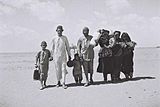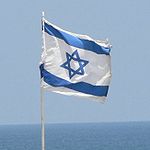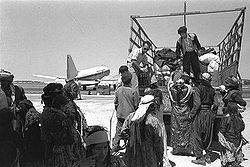- Operation Ezra and Nehemiah
-
From 1950 to 1952, Operation Ezra and Nehemiah airlifted between 120,000 to 130,000 Iraqi Jews to Israel[1][2] via Iran and Cyprus. The massive emigration of Iraqi Jews was among the most climactic events of Jewish exodus from Arab and Muslim countries. By 1968 only 2,000 Jews remained in Iraq. Today fewer than 100 Jews remain, all of whom live in Baghdad.
The operation is named after Ezra and Nehemiah, who led the Jewish people from exile in Babylonia to return to Israel in the 5th century BC, as recorded in the books of the Hebrew Bible that bear their names.
Contents
Background
Jewish exodus from Arab countries 1947-1972 
Main articles Jewish exodus from Arab and Muslim countries
Immigrant camps · Maabarot
1948 Arab-Israeli War
Operation Magic Carpet (Yemen)
Operation Ezra and Nehemiah
1956 Expulsion of Egyptian JewsBackground Nazi relations with the Arab world · Farhud · Tripoli (1945) · Cairo (1945) · Immigration during and after World War II
Israeli Declaration of Independence · Suez Crisis · Algerian War · Six Day WarKey incidents Aleppo (Syria) · Aden (Yemen) · Oujda and Jerada (Morocco) · Tripoli (Libya) · Baghdad (Iraq) Arbitration WOJAC · JIMENA · Babylonian Jewry Heritage · JJAC · The David Project Resettlement Aliyah · Law of Return · Development towns · North African Jewry in France Related topics Jewish history · Jewish diaspora · History under Muslim rule
Mizrahi Jews · Sephardi Jews · Arab JewsThe critical change in Iraqi Jewish identity occurred after the violent Farhud or pogrom against the Jews of Baghdad, on June 1–2, 1941 following the collapse of the pro-Nazi Golden Square regime of Rashid Ali al-Kaylani. At least 180 Jews were killed during two days of riots, and the Baghdadi Jewish community was irreversibly hit. After the Farhud, Jews began fleeing Iraq at an increasing rate.
After 1945, there were frequent demonstrations in Iraq against the Jews and especially against Zionism. In 1947, with the affirmation of the Partition Plan for Palestine, the Jews felt that their lives were in danger. Many received harsh legal sentences, or were forced to pay heavy fines.
On 23 October 1948, Shafiq Ades was executed, an event that increased the sense of insecurity among Jews.
Between 1949 and 1952, about 130,000 Jews immigrated to Israel from Iraq, thanks largely to the efforts of emissaries from Israel and activists of the "Halutz Movement" in Iraq. One of the key figures was Shlomo Hillel, an Iraqi Jew who went on to become a minister in the Israeli government.
The Exodus of Iraqi Jews to Israel lasted several months, and started after the Iraqi Government passed a special bill permitting their emigration in 1950. At first, few would register, as the Zionist movement suggested they not do so until property issues had been clarified. After mounting pressure from both Jews and the Government, the movement relented and agreed to registrations.
At first, the Iraqi emigration law allowed the Jews to sell their property and liquidate their businesses. However, later on the government would confiscate the property of Jews relinquishing their citizenship, including those who had already left. A series of bomb attacks against Jewish places and people, known as the 1950–1951 Baghdad bombings, began in March 1950 and sped up the desire for emigration to Israel.
Airlift
Aliyah to Israel
and settlement
Pre-Zionist Aliyah The Return to Zion
Old YishuvBefore May 14, 1948 First Aliyah · Second Aliyah
During World War I
Third Aliyah · Fourth Aliyah
Fifth Aliyah
During and after World War II
BrichaAfter May 14, 1948 Operation Magic Carpet
Operation Ezra and Nehemiah
1968 Polish aliyah
1970s Soviet Union aliyah
Aliyah from Ethiopia
1990s CIS aliyah
2000s Latin America aliyahConcepts Judaism · Zionism
Jewish homeland
Jewish messianism
Law of Return
Galut · YeridaPersons and
organizationsTheodor Herzl · Knesset
El Al · Nefesh B'Nefesh
World Zionist OrganizationRelated topics History of Israel
History of Zionism
Israeli Jews
Jewish diaspora
Jewish history
Jews in the Land of Israel
Religious Zionism
Revival of the Hebrew language · Yishuv Immigrants from Iraq leaving Lod airport on their way to ma'abara, 1951
Immigrants from Iraq leaving Lod airport on their way to ma'abara, 1951
Waiting in Baghdad was a tense and difficult period. Some 50,000 Jews signed up in one month, and two months later there were 90,000 on the list. This mass movement stunned the Iraqi Government, which had not expected the number of immigrants to exceed 8,000, and feared that administrative institutions run by Jews might collapse. At the same time, the Zionist movement issued a manifesto calling on the Jews to sign up for immigration. It started with the following: "O, Zion, flee, daughter of Babylon," and concluded thus: "Jews! Israel is calling you — come out of Babylon!"
The first planes flew to Israel via Cyprus in mid-May 1951. Several months later, a giant airlift operated directly from Baghdad to Lod airport. Operation Ezra and Nehemiah ended at the beginning of 1952, leaving only about 6,000 Jews in Iraq. Most of the 2,800-year-old Jewish community immigrated to Israel.
Aftermath
After the initial emigration, the number of Jews in Baghdad decreased from 100,000 to 5,000. Although they enjoyed a brief period of security during the reign of Abdul Karim Qassim, later regimes would seriously increase the persecution of Iraqi Jews[3]. In 1968 there were only about 2,000 Jews still living there. On January 27, 1969 nine Jews were hanged on charges of spying for Israel causing most of the remaining community to flee the country. Today fewer than 100 Jews remain.
Until Operation Ezra and Nehemiah there were 28 Jewish educational institutions in Baghdad, 16 under the supervision of the community committee and the rest privately run. The number of pupils reached 12,000 and many others learned in foreign and government schools. About 400 students studied medicine, law, economics, pharmacy, and engineering. In 1951 the Jewish school for the blind was closed; it was the only school of its type in Baghdad. The Jews of Baghdad had two hospitals in which the poor received free treatment, and several philanthropic services. Out of sixty synagogues in 1950, there remained only seven after 1970. Most public buildings were seized by the government for paltry or no compensation.[3]
See also
References
- ^ Pasachoff, Naomi E.; Robert J. Littman (2005). ""Operation Magic Carpet" and "Operation Ezra and Nehemiah"". A Concise History of the Jewish People. Rowman & Littlefield. p. 301. ISBN 0742543668. http://books.google.hu/books?id=p5EYccILQ7AC&pg=PA301&lpg=PA301&dq=Operation+Ezra+and+Nehemiah&source=web&ots=Bq-iFvnFTt&sig=YMvnFwKEZex0-Smo7scBDYn3ayM&hl=hu&sa=X&oi=book_result&resnum=7&ct=result. Retrieved June 28, 2008.
- ^ "Operations Ezra & Nechemia: The Aliyah of Iraqi Jews". Jewish Virtual Library. American-Israeli Cooperative Enterprise. http://www.jewishvirtuallibrary.org/jsource/Immigration/ezra.html. Retrieved June 27, 2008.
- ^ a b Nissim Kazaz, the end of an exile, life of Jews after the exodus, 1951–2000
Sources
- Mordechai Ben-Porat To Baghdad and Back: The Miraculous 2,000 Year Homecoming of the Iraqi Jews, Gefen Publishing House, 1998. ISBN 965-229-195-1
- Mahir Ünsal Eriş, Kürt Yahudileri – Din, Dil, Tarih, (Kurdish Jews) In Turkish, Kalan Publishing, Ankara, 2006
- Shlomo Hillel, Operation Babylon Fontana, Collins Press, 1988/89, translated from the Hebrew by Ina Friedman.
External links
- To Baghdad and Back – Book review from Babylonian Jewry Heritage Center web site
- Iraqi Jews who left Baghdad in the 1960's and 1970's – Jews who chose to stay in Iraq during Operation Ezrah and Nehamiah
- [1] The Jews of Iraq By Naeim Giladi.
- The Forgotten Refugees: the causes of the post-1948 Jewish Exodus from Arab Countries (focuses on Iraq)
Categories:- Aliyah
- Aliyah operations
- 20th century in Iraq
- Jewish Iraqi history
- Iraqi diaspora
- 1950 in Israel
- 1951 in Israel
- 1952 in Israel
- Non-combat military operations involving Israel
Wikimedia Foundation. 2010.
